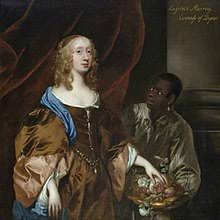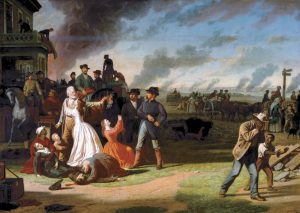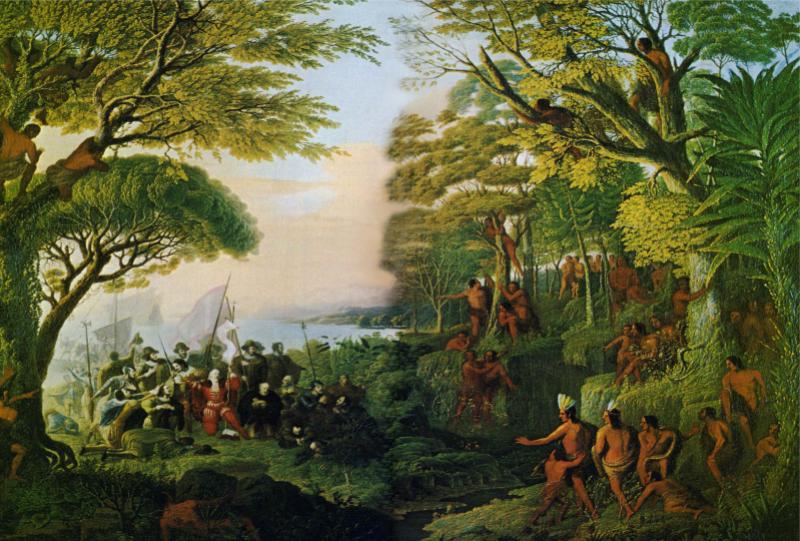All this talk about history and statues reminded me of my third-grade lessons in Mrs. Bennett’s class. It was there that I learned to recite this little ditty:
In fourteen hundred ninety-two
Columbus sailed the ocean blue…
October 12 their dream came true
You never saw a happier crew!
At seven years old, it seemed really important to know that the ships he sailed were the Nina, the Pinta, and the Santa Maria. It was also in that class that I learned to belt out “You’re a Grand Old Flag” with gusto! At that age, the irony of the situation was completely lost on me: the same school system that was specifically designed to ensure my conformity to the rules and roles of second class citizenship was equally committed to my indoctrination as a proud patriot. By the time I reached fourth grade I could sing all of the stanzas of “This Is My Country”, soprano and alto parts. However, I had yet to hold a new textbook in my hands or sit at an unmarred desk. You see, books and furnishings were delivered to my “colored” school only after they were considered too damaged to be used at the white schools. Both the students and teachers were trapped inside the contradiction of this educational system. Mrs. Bennett certainly resisted the set-up. I remember her facing down her colleagues who thought she should attempt to make her dilapidated desk look more “presentable” for the annual visit from the white superintendent. Although I couldn’t fully grasp the implications of their disagreement, I knew Mrs. Bennett was right. Now from a distance of decades, I have to wonder how she felt teaching us that we lived in a country where “liberty and justice for all” was a sacred creed, a claim that she knew to be not true.
Here is a quote attributed to humorist Josh Billings: “It is better not to know so many things than to know so many things that are not so”. How much of what we have been taught is simply not so? How many things were we not taught that were so? Much of what passes for American history are things that are simply not so. Likewise, much of what is so has been erased from the canon. To borrow an observation from Walter Brueggemann, it depends on who is telling the story, and for what purpose the story is being told. As the statue of Christopher Columbus was ripped from its base and toppled into the Baltimore Harbor, the current occupant in the White House launched a fusillade of threats against those who would “desecrate our common inheritance” and promised to defend the beautiful history of the United States, even if his quest to preserve our national culture took him to the top of Corcovado Mountain in Brazil. Other pundits and citizens voiced their disapproval in more measured and geographically accurate terms. The assumptions underlying their concerns seemed to coalesce around two fundamentalist assumptions. The first is that history is a compilation of irrefutable facts – no distortions, no elisions, no lies. The second is more pragmatic: history is over: what’s done is done; let bygones be bygones. Neither viewpoint is true.
“What Happened Was…”
How many times have we heard different people report the same event as very different stories? The Christopher Columbus I encountered in my third-grade lessons seems to have sprung straight out of the Paul Kane painting of the “discovery” of America. With his navigational bumbling excised from the story, and my seven-year-old brain was trained to interpret “discovery” as ownership, not as learning. Columbus came, Columbus saw, and the land quite automatically belonged to him. This rendering of the story didn’t even bother with the bloodletting, dismembering, enslaving, conquering part. With the Arawaks completely erased from the narrative, the “what happened” is reduced to a tale of daring, adventure, and heroism. In this story, Arawak lives did not matter.
Any talk about history is necessarily a talk about power: specifically, who has the power to tell the story and whose interests the telling serves. History is not now and has never been politically neutral. It serves to tell a particular kind of story, one that validates the motivations and outcomes executed by that pantheon of operatives who come to be known as “great men”. If history were a simple recording of “just the facts”, what we celebrate and memorialize would be much more complex and complete. We would be guided by fuller truths. Can we imagine, for example, how celebrations of Independence Day might change if we dared to grapple with its inherent contradictions? It might be wholly appropriate to venerate the Declaration of Independence for its aspirational claims on life, liberty, and pursuit of happiness. However, is it also necessary to ignore that among its compendium of grievances against George III was outrage that he incited the “merciless Indian savages” to resist domination or annihilation? Does it matter that one the “great men’” memorialized on Mount Rushmore castigated Virginia’s lord governor for offering freedom to enslaved Africans in exchange for loyalty to the Crown? While it is wholly appropriate to celebrate the first president’s rejection of monarchy and to sympathize with the agony of his dental pain, it is equally important to rebuke his sense of entitlement to his slaves’ teeth. 
The erasure of these fuller truths is not inconsequential. In these stripped-down, sanitized narratives, real humans become mythical creatures, devoid of the textured sensibilities and intellectual breadth required for establishing a new republic. In the absence of fuller truths, we are left with the myths of American innocence and exceptionalism, a nation highly favored in the eyes of God and market capitalism. From good old Columbus to the westward going pioneers, from the railroad barons to the architects of the invasion of Iraq, the narrative justifying dominative power is clear. Native American lives do not matter. Chinese lives do not matter. Iraqi lives do not matter. To gainsay this preferred narrative of power is to be dismissed as “revisionist”, or worse, unpatriotic. Clinging to the intertwined myths of innocence and exceptionalism is a death grip. It leaves us numb to the 21st-century atrocities that belie a factitious allegiance to truth, justice, and the American Way. We would be better equipped to contend with the carnage and sorrow of our present-day realities, were we to ground ourselves with the observation offered by James Baldwin: “American history is longer, larger, more various, more beautiful and more terrible than anyone has ever said about it”.
“It’s not even past.” ~ William Faulkner
In 1878, the Ladies Memorial Association of Augusta commissioned a 76 feet tall marble monument to “honor the men of Richmond County who died in the cause of the Confederate States. Featured on the granite base of the statue are life-size representations of four confederate generals, among them Stonewall Jackson and Robert E. Lee. The inscription begins:
Worthy
To have lived and known
our Gratitude
Worthy
To be honored and held
In tender remembrance.
This statue stands as a testament to William Faulkner’s wisdom: “The past is never dead. It’s not even past.” Statues are created to not only perpetuate memory, but also to proclaim aspirations and values. That the nice ladies of Augusta revered the Confederate cause is evident in their proclamation:
“No nation rose so white
and fair:
None fell so pure of crime.”
They were right about one thing: slavery was not a crime in the South. In fact, the dead whose honor is memorialized on that statute were willing to commit the crime of treason to ensure that slavery remained legal, not only in the South but throughout the nation. It is not by accident that the themes of innocence and exceptionalism are interpolated into this story of treason and human trafficking. Traits inscribed in granite on a memorial statue leach into human psyche. In this instance, they served to affirm the racialized story the nice ladies of the memorial association wanted to tell about themselves. These are the traits that function to affirm a way of life by providing “everyday” answers to existential questions: questions that shape our understanding of human meaning and possibility. Who belongs? What do I deserve, and in what measure? Who deserves respect, and in what measure? What makes my life matter? As Bruce Wexler points out in his book Brain and Culture, ceremonial objects (be they flags, marble statues, or ragtag signs) are prized because they are external manifestations of internal beliefs. I would add that they not only manifest, they also validate deeply held beliefs.
The past is not even past because the stories we tell about who we are live in our bodies and in our relationships. Because race functions to rank order human worth in our culture, the stories are laced through with anxiety and ambivalence. While they may or may not be fully conscious, they are never neutral. In 1878, the story told by the nice ladies of the Memorial Association was very clear, not only about who was deserving of honor and respect, but also what values needed to be upheld, as well as their own entitlements in their post-Reconstruction society. (I’m not saying their stories were without contradiction. Since “niceness” really has nothing to do with racism, I would guess that at least one of them would smile and pass a glass of sweet tea to her black maid, and then dress herself to attend a lynching picnic an hour later.) Today, what might upon first glance be presumed race-neutral is revealed upon further examination to be deeply racialized. For example, who would have guessed that during a pandemic, the responses to health protocol instructions would be infused with racist vitriol? How does one connect demands for “liberation!” with swastikas and KKK paraphernalia? What stories do these muscled white men, armed with fists and assault weapons tell themselves about who they are in the world? What stories do they want to manifest in the world? What versions of history undergird these stories?
We know that history is intervening in the present when an irksome parking lot incident turns into a potentially deadly encounter. What stories compel a mini-van driving white woman to leap from her vehicle and point a loaded gun at a black woman and her child? Her rants and ethnic slurs aside, this woman for sure was not a member of a post-Reconstruction Southern memorial association. In fact, at 32 years old, she could have sat beside one of my nieces in a racially integrated high school history class. Similarly, at 44 years old, Derek Chauvin would have had no lived experience in post Reconstruction society. We should wonder then how history informed his story of himself and how he carried that story into his relationships. He and George Floyd were likely taught the same history lessons in white supremacy, lessons enacted in the different, through everyday stories of their lives. What we know for sure is that one man died face down on the sidewalk crying for his deceased mother. The other sat calmly, hands in his pockets, and staring at the cameras while squeezing the last breaths out of another human being. There was nothing in Derek Chauvin’s face that suggested guilt or uncertainty. He embodied the confidence of a man who believed he had a right to annihilate an already subdued man. Like inscriptions honoring our Confederate forebears, he had no doubt that he was “pure of crime”. He embodied the certainty of a man who knows whose life matters.

“Make some good and necessary trouble.” ~ John Lewis (1940-2020)
Our internalized stories carry the emotional and political weight of history. They comprise much of what we call “identity” in the western world, and they are never neutral. Because these historicized stories anchor our sense of place and power in the world, we cling tenaciously to the images that make up our notion of self. Together with the perceptions and expectations we hold of others, we construct the story of how our world should work: who should belong, what we deserve, and what we must do to matter. Story-making itself is not problematic; it’s what we humans do to explain the world. However, when stories are grounded in historicized distortions and erasures, they leave us with fragile images of possibility; we are left with images too brittle to withstand the challenges, complexities, and contradictions of our 21st-century lives. When our sense of purpose and power is little more than an accretion of culturally conferred images, explosions of fear and rage become all too common. Nothing stirs up trouble like poking a person’s preferred images of herself (As a white colleague once said to me, “There’s nothing worse than being called a racist.”) Perhaps that explains why a bump in a fast-food parking lot can turn a 32-year-old mini-van driving mom into an epithet-hurling, gun-toting vigilante. We are well past the time when we need to start stirring up good and necessary trouble, the kind of trouble that leads to courageous and compassionate living in our multiracial world.
Making good and necessary trouble means that there are some things we need to stop doing – right now. One thing we should stop doing is tweaking a symbol and calling it racial justice. Should the NFL and the MLB change team names that denigrate and objectify groups of people? Absolutely. Contrary to often made claims, there is no dignity inherent in cartoon-like, stereotype-driven images of “redskin” mascots. The time is well past to reject the reductionistic logic that such naming perpetuates. Interestingly, the stereotypes evoked to make profits in the business of sports are the same stereotypes used to justify removal, appropriation of land, desecration of sacred ground, and government-sponsored genocide. On the other hand, black lives will matter not one whit more because the NFL hires someone to sing Lift Every Voice during the first week of the professional football season. (I have to admit to a bit of curiosity about metrics used to determine how much change one week of singing would make.) Here’s my point: the illusion of change is the most enduring form of stasis. Enough with the empty symbols.
We make good and necessary trouble when we stop trying to force-fit ourselves and others into puny images of human worth and possibility. Because we so often enact our “stories” without conscious intent, this form of cultural narcissism happens more than we want to believe. It happens when the white school librarian forces a brown-skinned second-grader to borrow picture books because her neutrally wired prejudices do not allow her to see the child as capable of reading chapter books. It happens when a white tenured professor tells a black-skinned woman that she should be satisfied with her grade because “people like her don’t have the academic horsepower” to be at an ivy league graduate school. It happens when we use whatever status or power we think we have to off-load the shame of racial oppression onto others. We have all been schooled in white supremacy both in the classroom and at the family dinner tables. We have all learned that culturally valued traits belong to white people. Yes, “they” can sing, dance, and play basketball, but “they” are also the carriers of sloth, crime, promiscuity. We even use the word “woolly-headed” to denote low intelligence or lack of “academic horsepower”.
Black or indigenous people of color are not immune to cultural narcissism. Scrambling to secure their place in the rank ordering of human worth, we too are susceptible to off-loading our shame onto whoever is deemed less worthy in the social order. I often recall the outrage of a fair-skinned woman when she was mistaken for an African American. “I am from Barbados”, she screamed at the facilitator. “Don’t ever associate me with slavery and that mess!”. Splitting off perceived negative traits is how cultural narcissism works, and it limits our growing into fully human beings.
Here’s what we can start doing – right now. We can start teaching young people fuller truths about our histories. We don’t have to start with the “chopping-off-the-hands-of-Arawaks” part of the Columbus story. We can still use the “ocean blue” ditty as a mnemonic device. However, we can stop teaching (however inadvertently) that discovery means possession. Believe me, a third-grader can get that. She would know that she should not have to give up her backpack filled with her belongings just because a bigger kid came along and happened to “discover” it.
Wouldn’t it be powerful if a third grader is taught a history that is large enough to hold our struggles, our failures, and our highest aspirations, even those we have betrayed in the past? And really, isn’t that the point of history? No matter who tells the story, the point of history is not self-congratulation (or the adulation of white selves or those who can gain admission into the status of “whiteness”). The point of history should be to prepare us for participation in democracy as fully enfranchised citizens. Wouldn’t it be powerful if we took the trouble to tell our American stories in ways that help us confront the present with courage and face the future with compassion for our shared humanity?




I will send this to each member of a small group in which I participate; a group of white people reading How to Be a n Antiracist.
I’m going to be re-teaching my 3rd grade self and working on unlearning the lessons of stories/“histories” told by white people. Then I’m going to work on my grade 10 self who learned about our Newfoundland culture and barely touched on the extinguished Beothuk people but spent much time on John Cabot. We didn’t learn about racism in Canada at all. I’m going to re-teach my university educated self to look critically at who’s telling the story and who benefits from that narrative. I’m adding this teaching to our current homeschool agenda for my grade 3 and grade 7 kids.
Thank you Maureen. Wise words as usual.
Patricia Moore
Tonight I attended a meeting of GBIO sponsered by St Paul AME with some organizing teaching included to shift from protest alone to power organizing. Made me thing of the Stone Center work and wish you here in Boston were or are connect to add to potential structural change in Police reform, Health Care, Housing, Homelessness and other core issues.
Reading this powerful reminder of the misinformation in school that caused me such shame and hurt as a child was rivoting. All of my teachers were white and I the only child of color in my classes until 7th grade. Never was there a positive, certainly not affirming lesson that I could relate to until I began my own research. As a university Professor preparing future teachers historical truth informs my lessons. Maureen, your words have provided so much more fuel for my lectures. Thank you.
This line of yours really hit me, “the illusion of change is the most enduring form of stasis.” This is so important to keep in mind. We elect a biracial president so we must be living in a post-racial world. The Supreme Court rules that the Voting Rights Act doesn’t need to be extended because the conditions that necessitated it no longer exist. How then to explain Trumpism, voter suppression and continued incidents of extrajudicial killings of Black lives by the state? I read somewhere that for White people, While Supremacy is like the air we breathe – such a part of our lives that we don’t even see it – and that the only way to dismantle systemic racism is to learn It’s history. If children don’t learn the complexities of the Columbus story, the status quo is preserved. As you say, the children can handle that story.
Maureen- I’m appreciating your strong, clear, courageous voice once again!!